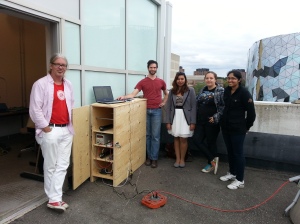We’re proud to announce that SOLTA is being developed as a high school course. When this project was first started, we had our hearts set on working with high schools, but the dream was so big that we didn’t dare to aim higher than extracurricular involvement. With SOLTA as a course, we’ll have the opportunity to get our message to more students and we’re ecstatic.
We’re very thankful to Michael Franchino, physics teacher at Huron Heights Secondary School in York Region. For a course to be approved at a high school in Ontario, the application has to be put forth by a teacher who works there, and Michael is our guy! The education team is currently working with him to develop the course application and we’re starting to write an online resource for the project that can be used as a textbook in the classroom.
Meanwhile, on the technological side, things are going great. We have a detector on our roof taking data and we’re continuing to develop the detector and the associated software.
Expect more updates soon! The education team is meeting with Michael Franchino next week to talk about the proposal and get the go-ahead on our plan for the online resource.




